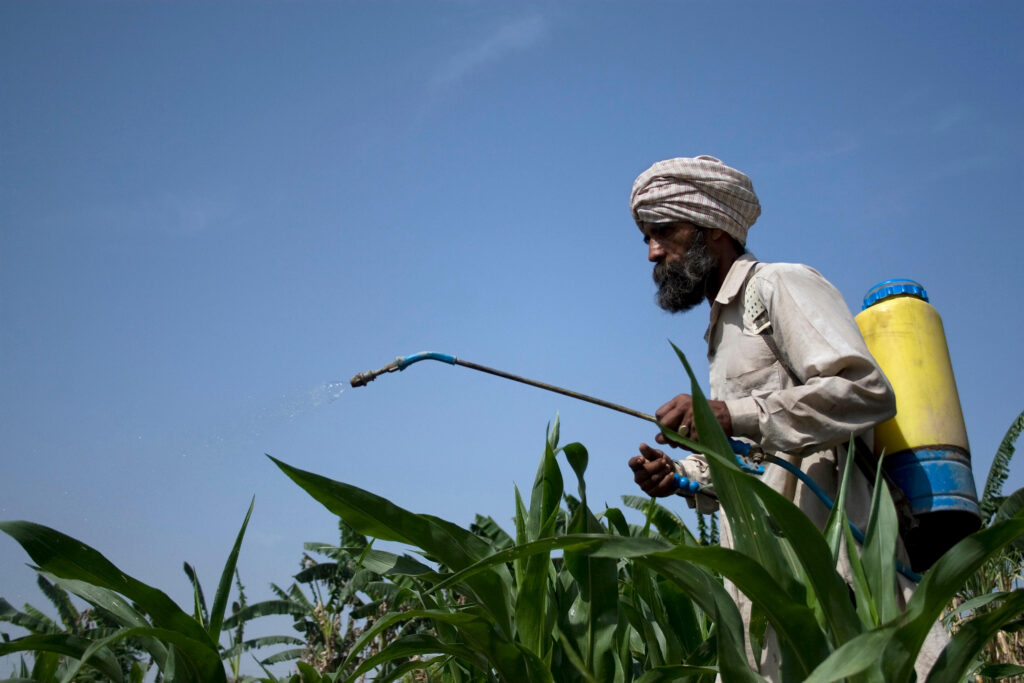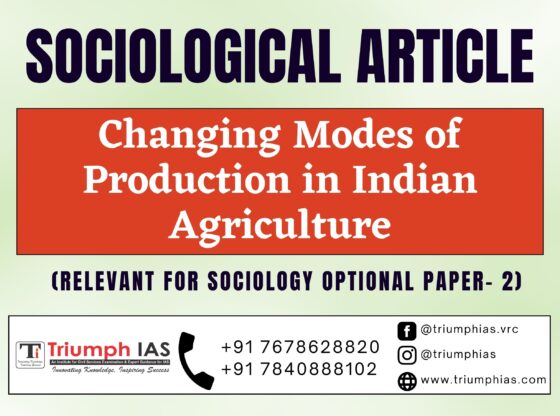Changing Modes of Production in Indian Agriculture
Relevant for sociology optional Paper- 2 (Unit- 13 : Social Changes in India)

Agriculture has been the backbone of the Indian economy for centuries. It is the largest employer in the country and is crucial for food security and economic development. However, the agriculture sector in India has undergone significant changes in the last few decades. This article will discuss the changing modes of production in Indian agriculture.
Before the Green Revolution, Indian agriculture was predominantly subsistence-based and was characterized by low productivity, traditional methods of cultivation, and low levels of mechanization. The Green Revolution, which began in the 1960s, brought about significant changes in Indian agriculture. The Green Revolution was a package of technologies that included high-yielding varieties of seeds, fertilizers, pesticides, and irrigation facilities. The new technology led to a significant increase in agricultural productivity and helped India become self-sufficient in food production. The Green Revolution was successful in increasing agricultural productivity, but it also led to several environmental problems like soil degradation, water scarcity, and loss of biodiversity.
The post-Green Revolution era has witnessed significant changes in Indian agriculture. The traditional subsistence-based agriculture has been replaced by commercial agriculture, which is more market-oriented and profit-driven. The adoption of modern technology and mechanization has led to an increase in agricultural productivity and efficiency. However, these changes have also led to several problems like rural-urban migration, land fragmentation, and declining soil fertility.
One of the significant changes in Indian agriculture has been the shift from traditional crops to high-value commercial crops. The production of crops like fruits, vegetables, and flowers has increased significantly in the last few decades. These crops are more profitable than traditional crops and have high demand in the domestic and international markets. However, the cultivation of commercial crops requires significant investment in terms of infrastructure, technology, and marketing. Small and marginal farmers find it challenging to shift to commercial crops due to the high initial investment and the lack of access to credit and technology.
Another significant change in Indian agriculture has been the adoption of modern technology and mechanization. The use of tractors, harvesters, and other farm machinery has increased significantly in the last few decades. The adoption of modern technology has led to an increase in agricultural productivity and efficiency. However, the high cost of farm machinery and the lack of access to credit and technology has prevented small and marginal farmers from adopting modern technology.
The changing modes of production in Indian agriculture have also led to changes in the social and economic structure of rural areas. The decline in traditional agriculture has led to rural-urban migration, as farmers look for alternative sources of income. The migration of labour from rural to urban areas has led to a shortage of labour in the agriculture sector. This shortage of labour has led to an increase in the use of machines and modern technology in agriculture.
The changing modes of production in Indian agriculture have also led to changes in land ownership and fragmentation. The Green Revolution led to the concentration of land in the hands of a few wealthy farmers, who could afford to invest in modern technology and infrastructure. This concentration of land ownership has led to the fragmentation of land holdings, as farmers with small landholdings are forced to sell their land to larger farmers. The fragmentation of land holdings has led to a decline in agricultural productivity and efficiency.
The changing modes of production in Indian agriculture have also led to changes in the agricultural market structure. The shift to commercial crops has led to the emergence of new market channels and value chains. The emergence of new market channels has provided farmers with better access to markets and higher prices for their products. However, the dominance of intermediaries in the market has led to low prices for farmers and high prices for consumers.
In conclusion, the changing modes of production in Indian agriculture have brought about significant changes in the social, economic, and environmental aspects of rural areas. The adoption of modern technology and mechanization has led to an increase in agricultural productivity and efficiency, but it has also led to several challenges such as land fragmentation, declining soil fertility, and rural-urban migration. Therefore, there is a need for a sustainable approach to agriculture that promotes the use of modern technology while preserving the environment and ensuring the socio-economic well-being of farmers. The government should take initiatives to promote sustainable agriculture practices and provide small and marginal farmers with access to credit, technology, and marketing facilities. This will not only ensure food security but also promote rural development and improve the standard of living of farmers.
For more such free UPSC notes, Articles, News & Views Join our Telegram Channel. https://t.me/triumphias
Click the link below to see the details about the UPSC – Civils courses offered by Triumph IAS. https://triumphias.com/pages-all-courses.php


